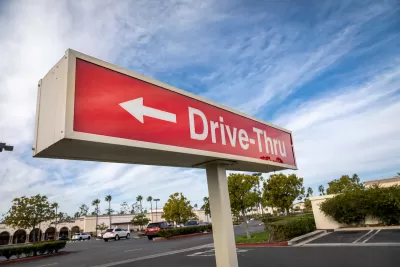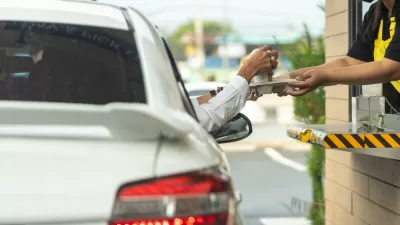Dining areas in many fast food restaurants are being replaced with added drive-thru lanes, another post-pandemic impact on our lives benefiting those with four wheels (or more).

“Maybe I’m lazy,” said the smiling University of South Alabama senior whose very happy photo inside her vehicle holding a Starbucks drink is most telling, “but it’s something about the car,” she tells a food reporter for The New York Times to explain why she “loves them so much she pulls into one at least eight times a week," referring to drive-thru facilities.
“Getting a meal through a car window began to define the nation’s food culture the moment the founders of In-N-Out Burger set up a two-way speaker in 1948,” writes Kim Severson who covers the nation's food culture for The New York Times on November 7.
[Related in Planetizen: “Drive-Thrus Banned at Birthplace,” August 4, 2010. Nate Berg reports on that drive-thru in Baldwin Park, California, and the city's attempt to address “‘in-car’ dining culture.”]
But the drive-through has never been as integral to how America eats as it is now.
And Severson has the data to prove it.
Drive-through traffic rose 30 percent from 2019 to 2022...Meanwhile, the number of people eating inside fast-food restaurants in the first half of 2023 fell by 47 percent from the same period in 2019. Drive-throughs now account for two-thirds of all fast-food purchases, according to a September report by Revenue Management Solutions.
Among the many reasons explaining the resurgence of drive-throughs this one was among the most surprising, what Severson called a “societal sea change:”
People emerged from the pandemic with less tolerance for interacting with strangers.
“These are all sorts of ways people are prioritizing safety. The drive-through mentality keeps people both physically and psychologically safe,” said Shelley Balanko, a social scientist and senior vice president with the Hartman Group, a research company that studies American eating patterns.
One of the many people interviewed in their vehicles in fast food parking lots for the piece perhaps said it best.
Before the pandemic, he would go inside restaurants like McDonald’s to eat. Now he sticks to the drive-through. “I got out of the habit,” he said. “I think I’m like a lot of people who just don’t necessarily like being social that much anymore.”
FULL STORY: Hungry (but Not for Human Contact), Americans Head for the Drive-Through

Maui's Vacation Rental Debate Turns Ugly
Verbal attacks, misinformation campaigns and fistfights plague a high-stakes debate to convert thousands of vacation rentals into long-term housing.

Planetizen Federal Action Tracker
A weekly monitor of how Trump’s orders and actions are impacting planners and planning in America.

San Francisco Suspends Traffic Calming Amidst Record Deaths
Citing “a challenging fiscal landscape,” the city will cease the program on the heels of 42 traffic deaths, including 24 pedestrians.

Defunct Pittsburgh Power Plant to Become Residential Tower
A decommissioned steam heat plant will be redeveloped into almost 100 affordable housing units.

Trump Prompts Restructuring of Transportation Research Board in “Unprecedented Overreach”
The TRB has eliminated more than half of its committees including those focused on climate, equity, and cities.

Amtrak Rolls Out New Orleans to Alabama “Mardi Gras” Train
The new service will operate morning and evening departures between Mobile and New Orleans.
Urban Design for Planners 1: Software Tools
This six-course series explores essential urban design concepts using open source software and equips planners with the tools they need to participate fully in the urban design process.
Planning for Universal Design
Learn the tools for implementing Universal Design in planning regulations.
Heyer Gruel & Associates PA
JM Goldson LLC
Custer County Colorado
City of Camden Redevelopment Agency
City of Astoria
Transportation Research & Education Center (TREC) at Portland State University
Jefferson Parish Government
Camden Redevelopment Agency
City of Claremont




























